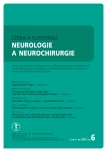Idiopathic Superficial Siderosis – a Case Report
Authors:
D. Krajíčková 1; L. Klzo 2; A. Krajina 2
Authors‘ workplace:
LF UK a FN Hradec Králové
Neurologická klinika
1; LF UK a FN Hradec Králové
Radiologická klinika
2
Published in:
Cesk Slov Neurol N 2013; 76/109(6): 759-762
Category:
Case Report
Overview
Superficial siderosis (SS) of the central nervous system (CNS) is a rare, progressive, irreversible and debilitating disorder in which hemosiderin – a blood degradation product – is deposited in the subpial layers of the brain and spinal cord, leading to loss of neurons and myelin and development of neurological deficit. Clinical presentation of SS is characterized by a typical triad of symptoms consisting of adult-onset slowly progressive cerebellar ataxia, signs of myelopathy and sensorineural hearing impairment. MR imaging shows a characteristic T2 hypointensity around the brain stem, cerebellum, and spinal cord. The authors present a case of a woman with progressive hearing impairment from 53 years of age and gradual development of deteriorating paleocerebellar and spinal symptoms. Despite extensive imaging, the source of bleeding has never been identified.
Key words:
siderosis – magnetic resonance – ferritin – haemosiderin – cerebellar ataxia – deafness
The authors declare they have no potential conflicts of interest concerning drugs, products, or services used in the study.
The Editorial Board declares that the manuscript met the ICMJE “uniform requirements” for biomedical papers.
Sources
1. Gautham R. Superficial siderosis of the CNS. Baylor Neurology Case of the Month [on-line]. Available from URL: http:/ / www.bem.tcm.edu/ neurol/ challeng/ pat46/ selftest.html.
2. Kumar N, Cohen-Gadol AA, Wright RA, Miller GM, Piepgras DG, Ahlskog JE. Superficial siderosis. Neurology 2006; 66 (8): 1144– 1152.
3. Levy M, Llinas RH. Pilot safety trial of deferiprone in 10 subjects. Stroke 2012; 43(1): 120– 124.
4. Brabcová L, Ulmanová O, Viták T, Faltýnová E, Roth J.Superficiální hemosideróza centrálního nervstva: klinicko‑patologický přehled a kazuistika. Cesk Slov Neurol N 2005; 68/ 101(5): 349– 352.
5. Fearnley JM, Stevens JM, Rudge P. Superficial siderosis of the central nervous system. Brain 1995; 118(Pt 4): 1051– 1066.
6. Aquilina K, Kumar R, Lu J, Rawluk D. Superficial siderosis of the central nervous system following cervical nerve root avulsion: the importance of early diagnosis and surgery. Acta Neurochir 2005;147(3): 291– 297.
7. Levy M, Turtzo Ch, Llinas RH. Superficial siderosis: a case report and review of the literature. Nat Clin Pract Neurol 2007; 3(1): 54– 58.
8. Kumar N. Neuroimaging in superficial siderosis: an in‑depht look. AJNR Am J Neuroradiol 2010; 31(1): 5– 14.
9. Feldman HH, Maia LF, Mackenzie IR, Foster BB, Martzke J, Woolfenden A. Superficial siderosis: a potencial diagnostic marker of cerebral amyloid angiopathy in Alzheimer disease. Stroke 2008; 39(10): 2894– 2897.
10. Linn J, Herms J, Dichgans M, Brückmann H, Fesl G,Freilinger T. Subarachnoid hemosiderosis and superficial cortical hemosiderosis in cerebral amyloid angiopathy. AJNR Am J Neuroradiol 2008; 29(1): 184– 186.
11. Ellie E, Camou F, Vital A, Rummens C, Grateau G,Delpech M et al. Recurrent subarachnoid hemorrhage associated with a new transthyretin variant (Gly53Glu). Neurology 2001; 57(1): 135– 137.
12. Koeppen AH, Dickson AC, Chu RC, Thach RE. The pathogenesis of superficial siderosis of the central nervous system. Ann Neurol 1993; 34(5): 646– 653.
13. Koeppenn AH, Michael SC, Li D. The pathology of superficial siderosis of the central nervous system. Acta Neuropathol 2008; 116(4): 371– 382.
14. Kumar N, Lane JI, Piepgras DG. Superficial siderosis: sealing the defect. Neurology 2009; 72(7): 671– 673.
15. Scheid R, Frisch S, Schroeter ML. Superficial siderosis of the central nervous system – treatment with steroids? J Clin Pharm Ther 2009; 34(5): 603– 605.
Labels
Paediatric neurology Neurosurgery NeurologyArticle was published in
Czech and Slovak Neurology and Neurosurgery

2013 Issue 6
Most read in this issue
- Frontotemporal Lobar Degeneration from the Perspective of the New Clinical‑ Pathological Correlations
- Tuberous Sclerosis Complex in Children Followed from Neonatal Period for Prenatally Diagnosed Cardiac Rhabdomyoma – Two Case Reports
- Pineal Region Expansions
- Occipital Condyle Fractures
